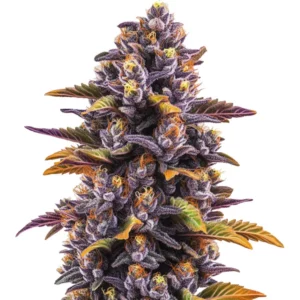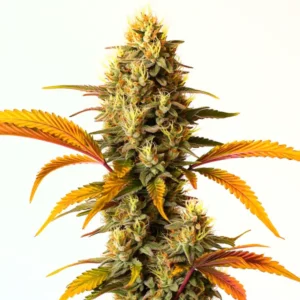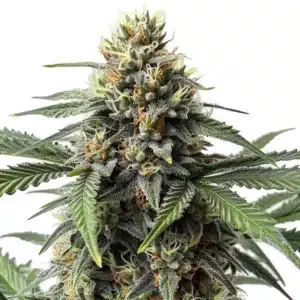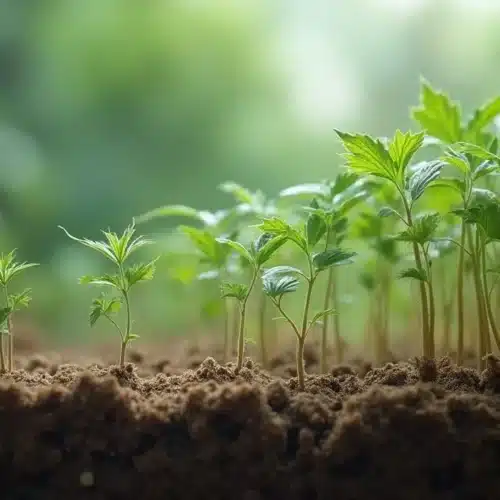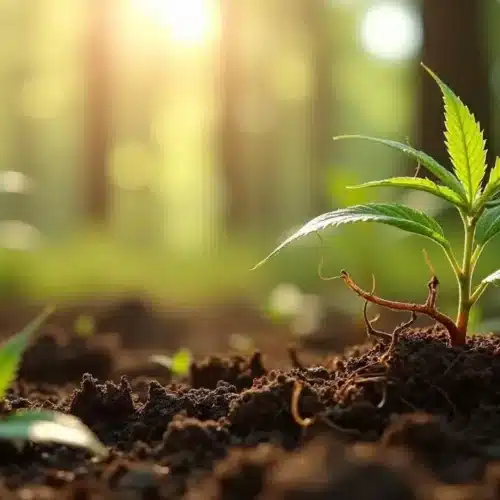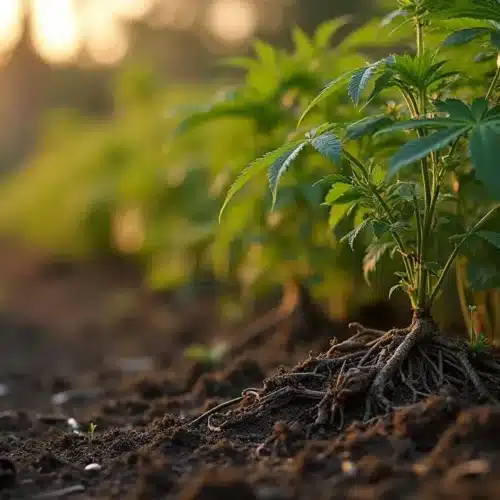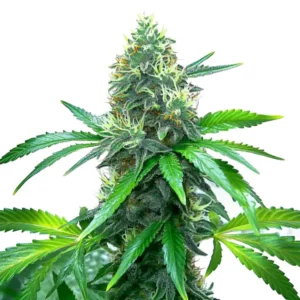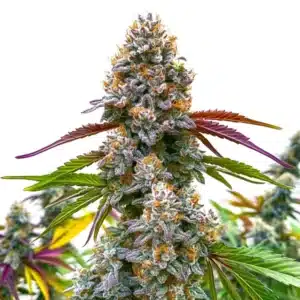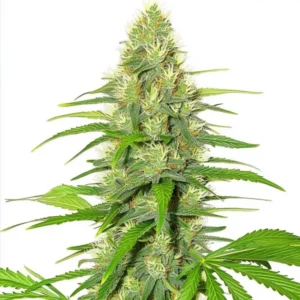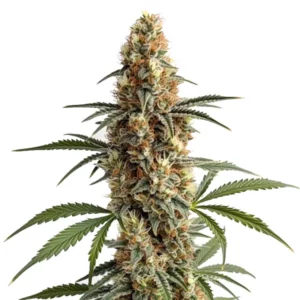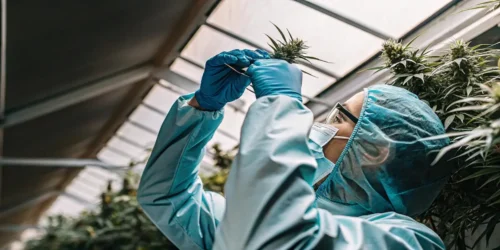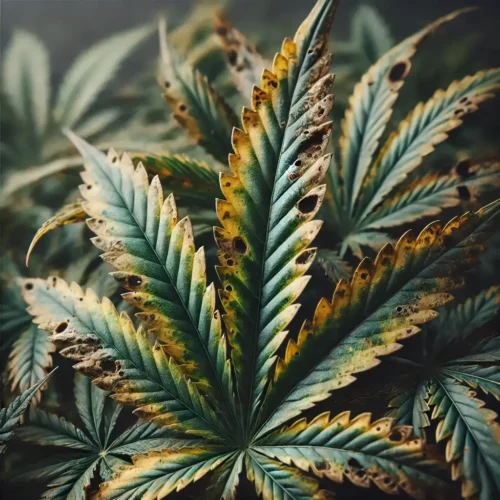Yellow fungus on cannabis roots can be a real headache for growers. This sneaky problem often stays hidden until it starts affecting your plant’s health. If you’re noticing stunted growth or discolored leaves, your cannabis roots might be under attack. Yellow fungus, also known as root rot, thrives in overly moist environments. It can quickly derail your gardening efforts if not managed properly.
Think of your cannabis roots as the lifeline of your plants. When yellow fungus sets in, it’s like a clogged artery. Nutrients and water struggle to reach their destination. You might not see the roots every day, but they are the backbone of your plant’s health. Keeping them free from yellow fungus is crucial for a successful harvest.
Yellow fungus on cannabis roots is more common than you might think. Even seasoned growers encounter it from time to time. Recognizing the symptoms early and knowing how to treat them can save your crop. It’s all about being proactive and paying attention to the little details.
Causes of Yellow Fungus on Cannabis Roots
The causes of yellow fungus on cannabis roots are often related to environmental conditions. Overwatering is one of the biggest culprits. When waterlogged, the roots can’t breathe, creating a perfect breeding ground for fungus. Poor drainage is another factor that can lead to the same result.
Temperature and humidity also play significant roles. Cannabis plants thrive in a balanced environment. When it’s too humid or the temperature fluctuates wildly, the risk of yellow fungus increases. Keeping your growing space consistent is key to preventing outbreaks.
Beyond overwatering and poor drainage, soil composition is another factor contributing to yellow fungus on cannabis roots. When soil is too compact, it restricts airflow, which is crucial for root health. Ensuring that your soil is well-aerated and light can prevent these issues from taking hold.
Another cause can be the use of contaminated tools or pots. If these are not properly sanitized between uses, they can introduce yellow fungus to a new batch of plants. Practicing good hygiene and cleanliness in your growing space is essential in preventing the spread of root diseases.
Identifying Symptoms of Yellow Fungus
Symptoms of yellow fungus on cannabis roots aren’t always obvious. Look for signs like yellowing leaves, which might seem like a nutrient deficiency at first. Wilting or drooping plants can also indicate root problems. Your plants are trying to tell you something isn’t right.
Another symptom is a musty smell coming from the soil. This odor is a red flag that your roots may be rotting. Healthy roots should smell earthy, not stale or sour. Checking the smell can be a quick way to diagnose potential issues.
In addition to these symptoms, you might notice that your plants are not absorbing nutrients effectively. This can manifest in a variety of deficiencies, despite adequate feeding. Monitoring for uneven growth patterns or discolored leaves can provide further insight into root health.
Yellow fungus on cannabis roots can also lead to increased susceptibility to pests and diseases. Weakened roots struggle to support the plant’s immune system, making it easier for other problems to take hold. Vigilance and regular inspection are your best tools in identifying and addressing these symptoms early.
Promos & Deals
Preventing Yellow Fungus on Cannabis Roots
Preventing yellow fungus is easier than dealing with an active outbreak. Start with your watering routine. Allow the topsoil to dry out between waterings. This reduces the chances of your roots sitting in stagnant moisture.
Good drainage is another preventative measure. Use pots with drainage holes and consider adding perlite to your soil mix. This helps excess water escape, keeping the root zone healthy. Remember, happy roots lead to happy plants.
Regularly rotating your plants can also aid in preventing yellow fungus on cannabis roots. This ensures that no single part of the plant is constantly exposed to excess moisture or inadequate airflow. Keep an eye on the layout of your grow space to allow for optimal air circulation.
Diversifying your plant care routine can also be beneficial. Introducing beneficial microbes to your soil can help compete with harmful fungi, reducing the chance of yellow fungus taking hold. These microbes can bolster root health and improve your plant’s resilience to environmental stressors.
Maintaining Ideal Growing Conditions
Maintaining consistent temperature and humidity levels is crucial. Invest in a good thermometer and hygrometer to monitor your environment. Cannabis plants generally prefer temperatures between 68-77°F with humidity levels around 40-60% during the vegetative stage.
If you’re growing indoors, consider using fans and dehumidifiers. These tools help control the environment and reduce the risk of yellow fungus. Adjustments may be needed as your plants grow and seasons change.
Lighting can also influence the ideal growing conditions. Ensure that your plants receive the appropriate amount of light for their growth stage. Proper lighting helps plants photosynthesize effectively and can keep the environment warm and dry, reducing the risk of yellow fungus.
Regularly calibrating your environmental tools is essential to ensure they provide accurate readings. Misleading data can result in improper adjustments, inadvertently creating conditions that favor the growth of yellow fungus on cannabis roots. Precision in monitoring can make a significant difference in prevention.
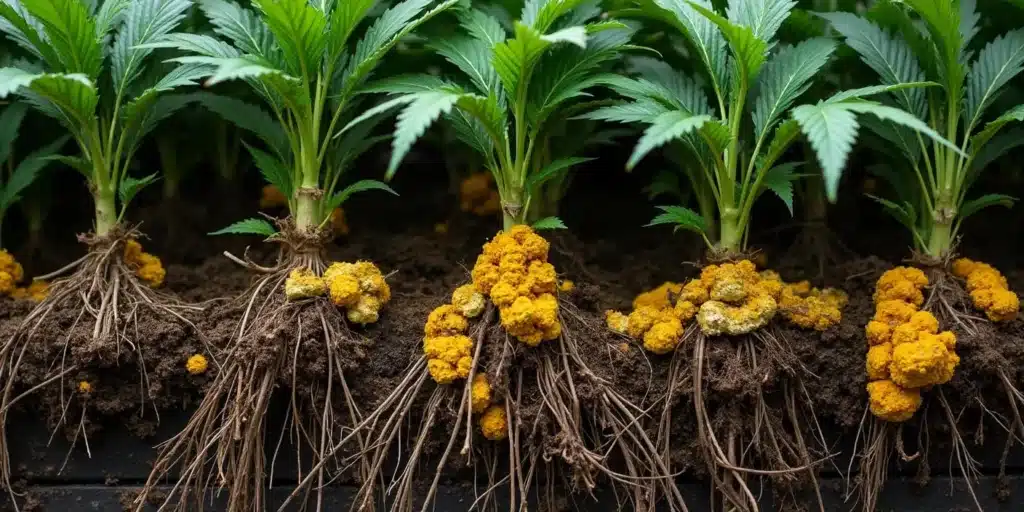
How to Treat Yellow Fungus on Cannabis Roots
If yellow fungus on cannabis roots is already affecting your plants, don’t panic. There are several ways to tackle the problem. The first step is to stop watering until the soil dries out. This can help to slow down the spread of the fungus.
Consider using a fungicide designed for root problems. Organic options are available if you’re concerned about chemicals. Follow the instructions carefully to ensure effective treatment. Fungicides can help eliminate the fungus, giving your plants a second chance.
In addition to chemical treatments, improving the environmental conditions can aid recovery. Ensure that your grow room is well-ventilated and that the temperature and humidity are within the ideal range. This creates an unfavorable environment for yellow fungus to thrive.
Regularly inspecting and cleaning your growing equipment can also help in treating yellow fungus. Sanitizing tools and pots can prevent further contamination and support the recovery process. It’s important to maintain a clean space to give your plants the best chance at recovery.
Repotting and Root Pruning
In severe cases, you might need to repot your plants. Remove as much of the infected soil as possible and trim away any damaged roots. This process can be stressful for the plant, so it should be a last resort. However, it can save your crop if done correctly.
When repotting, use fresh soil and a clean pot. This reduces the risk of reintroducing the yellow fungus. Make sure the new pot has adequate drainage to prevent future issues. It’s all about creating a fresh start for your plants.
After repotting, it’s critical to monitor the plant’s recovery closely. Look for signs of new growth and ensure that the plant is responding well to the new conditions. Patience and consistent care will be key in seeing your plants return to full health.
Root pruning should be done with care and precision. Use sterilized tools to prevent introducing new pathogens and take only what is necessary to allow the plant to recover. This delicate balance can be crucial in aiding the plant’s recovery from yellow fungus on cannabis roots.
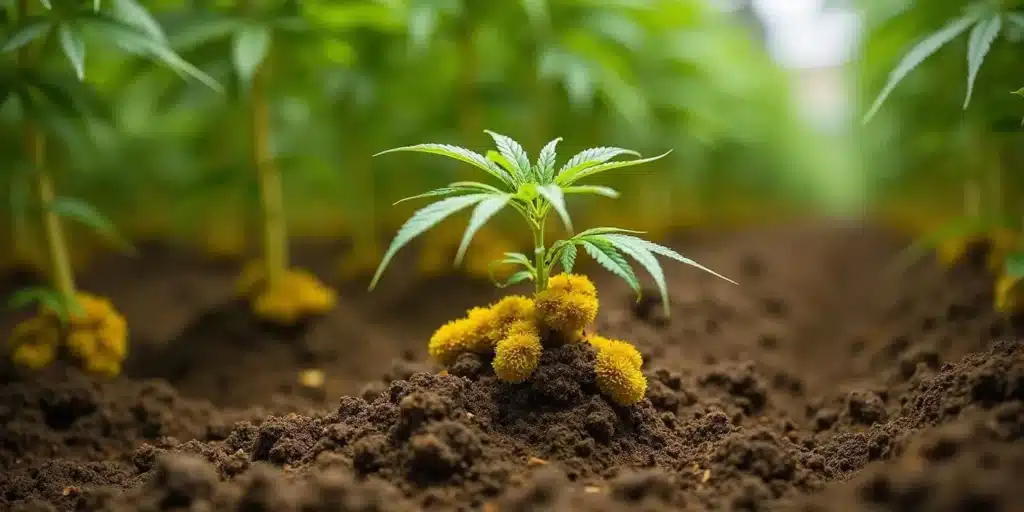
FAQ Section
What are the common signs of yellow fungus on cannabis roots?
Common signs include yellowing leaves, wilting, and a musty smell from the soil. These symptoms might be mistaken for other issues, so it’s important to check the roots directly. Healthy roots are white and firm, while affected roots appear brown and mushy.
Another sign to watch for is stunted growth. If your plants are not growing as expected, it may be due to root problems. Regularly inspecting your plants and knowing what to look for can help you catch yellow fungus early.
Pay attention to any unexpected changes in your plant’s appearance or vigor. Discoloration or unusual patterns on the leaves can often be traced back to issues with the roots. Understanding these symptoms can help in diagnosing yellow fungus on cannabis roots accurately.
Additionally, keep an eye on your plants’ nutrient uptake. If your feeding routine doesn’t seem to be having the expected effect, it could indicate that the roots are compromised by yellow fungus. Regular assessments can keep your plants healthy and productive.
How can I prevent yellow fungus from affecting my cannabis root health?
To prevent yellow fungus, focus on proper watering techniques and ensure good drainage. Allow the topsoil to dry out between waterings and use pots with drainage holes. Consider adding perlite to your soil mix to improve aeration.
Maintaining a consistent environment is also crucial. Keep temperature and humidity levels in check, and use fans or dehumidifiers if necessary. Choosing resistant strains like those from Blimburn Seeds can provide an extra layer of protection.
Implementing a regular cleaning schedule for your growing area can also help in preventing yellow fungus on cannabis roots. Removing debris and sanitizing surfaces reduces the risk of fungal spores settling into your soil.
Incorporating beneficial fungi and bacteria into your soil can enhance root health and resilience. These organisms can help outcompete harmful fungi, reducing the likelihood of yellow fungus taking hold in your garden.
Why is yellow fungus more common in certain growing conditions?
Yellow fungus thrives in overly moist and humid environments. Overwatering and poor drainage create ideal conditions for its growth. Temperature fluctuations can also stress plants, making them more susceptible to root problems.
Managing your growing environment effectively can reduce the risk of yellow fungus. Consistency is key, so monitoring your setup regularly will help you maintain healthy conditions for your cannabis plants.
Soil composition also plays a role in yellow fungus proliferation. Dense or compacted soil limits airflow, creating an environment where fungal growth is more likely to occur. Ensuring your soil is well-aerated can mitigate these risks.
Changes in the seasons can also influence the growing conditions. As temperatures and humidity levels shift, adjusting your care routine accordingly can prevent yellow fungus on cannabis roots from becoming a problem.
Are there any cannabis strains particularly resistant to yellow fungus?
Yes, some strains are more resilient against root problems. For example, Grizzly Purple Kush, OG Kush, and Critical Daddy Purple from Blimburn Seeds are known for their hardiness. These strains can be a good choice if you’re worried about yellow fungus.
Choosing a resistant strain can give you peace of mind and reduce the chances of encountering root issues. Always consider strain characteristics when planning your grow.
Researching the genetics of each strain can provide insights into their resistance to yellow fungus on cannabis roots. Some strains have been specifically bred for resilience, making them ideal for growers looking to minimize root issues.
Consulting with other growers or seed banks can provide valuable information on which strains are best suited to your growing conditions. This community knowledge can be incredibly useful in selecting the right strain for your needs.
What steps should I take if I find yellow fungus on my cannabis roots?
If you discover yellow fungus, start by letting the soil dry out to slow its spread. Consider using a fungicide specifically designed for root problems. Follow the product instructions for the best results.
In severe cases, repotting might be necessary. Remove infected soil and trim damaged roots before placing your plant in fresh soil. Monitor your plant closely after treatment to ensure recovery and continued health.
After addressing the immediate problem, take steps to improve your overall growing environment. This might include adjusting your watering routine, enhancing air circulation, or modifying your soil composition to prevent future issues.
Documenting your treatment process can be helpful for future reference. By noting what worked and what didn’t, you can refine your approach in managing yellow fungus on cannabis roots and improve your success rate in future grows.


